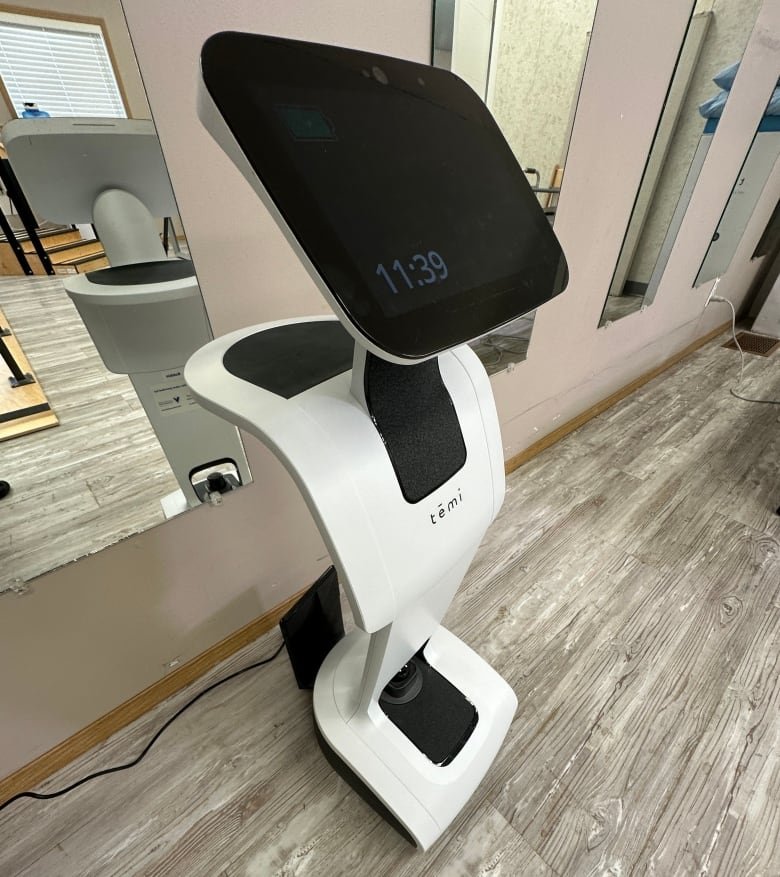Rehabilitation and physiotherapy services can be crucial in maintaining quality of life, especially as people age, but many in rural Manitoba have had little to no access to those services.
Now regular and essential physio and rehab services are being offered to people in Pinaymootang First Nation and Lake Manitoba First Nation through the help of a videoconferencing robot, while the physiotherapist remains in another city.
Clinton Anderson from Pinaymootang First Nation is seeing the benefits of this service. Nearly two years ago, Anderson was nearly killed in a workplace crash. He was driving down a winter road in Ontario when a semi-truck collided with his truck, leaving Anderson with multiple lacerations, broken bones and a concussion.
“My life is no longer the same from what it was before,” Anderson said.
Anderson’s recovery was made even more difficult by the lack of available physiotherapy and rehabilitation services close to Pinaymootang. Anderson often travelled to different communities — like to Winnipeg, over 200 km to the south — and saw different physiotherapists.
“At one time there, I was probably seeing maybe six different therapists,” he said. “Seeing a different one every month and it’s just like you’re back to square one every time.”

Anderson and others in both Pinaymootang and Lake Manitoba First Nation are now able to access more regular appointments for rehab and physio through tele-rehabilitation services made available in two Interlake communities through a collaboration among Interlake-Eastern Regional Health Authority, Riverview Health Centre and the University of Manitoba.
Remote physio with hands-on help
“I can sign in from my office in [Winnipeg] with my laptop and I can move the robot around as I need to,” physiotherapist Tim Romanec said.
“I can rotate it. I can change the camera angle up or down, side-to-side, and that allows my rehab assistant [on site in the community] to be hands-free and just worry about working with the client.”
The robot, made by Temibots, is an autonomous AI assisted piece of equipment than Romanec can control from Winnipeg using voice commands. It has cameras and sensors, and can navigate the room and around obstacles. Clients see Romanec’s face on the screen and can interact with him just like a video call.
“The goal is to lessen the burden on the health-care system,” he said. “With us being able to see people in different parts of Manitoba and more rural settings, it should be able to lessen the strain on the system.”

The robot, who the team has dubbed Wall-E, allows Romanec to see his client and their therapy session from every angle. He can ensure the client’s rehab movements and exercises are being done correctly despite being hundreds of kilometres away, while his assistant is in the room offering all of the hands-on work that needs to be done.
The service is also being offered in both Ashern and Eriksdale. Romanec splits his time between the communities, offering a combination of both remote and in-person appointments each month.
Romanec said people are getting continual and consistent care that can help them stay pain-free, and stay independent and healthier longer.
“It’s not that people don’t need physio, it’s that they just don’t have the easiest access to physio,” he said.
“It’s important to maintain quality of life so people can do the things they like to do and they need to do and keep their mobility and their function as they age.”
Remote care helps bridge gap
Remote services are one way to help fill vacancies and deal with retention issues that are plaguing health care in Manitoba.
“We had one doctor when I was growing up. He was here for two half-days a week and that was it,” Lawrence West, health director for Lake Manitoba, said. “All of our services were either in one of the local hospitals while they had services still available.”
But over time, West said those services moved to larger centres like Winnipeg and Brandon, leaving places like Lake Manitoba without.
“When they remove or restrict services from these areas, they’re lessening the quality of life of the people that live in those areas. I’ve seen a lot of my people who suffer without access to services and I’m a big believer that services delivered locally make the community healthier.”
The goal is to expand the services being offered to include access to occupational therapy and speech therapy.
Dwayne Moar, 78, has had longstanding injuries from his younger years that never healed properly.
“I couldn’t bend down to tie my shoes,” he said. “When you’re getting up in age all these little injuries come back to haunt you.”
For years, Moar was unable to make the trek from Lake Manitoba First Nation into Winnipeg — a little over 150 kilometres — to work on his mobility and strength. Moar is retired and lives on a fixed income through his pension.
“I’m older now. My driving is [limited.] Travelling back and forth now that the [price of] gas is so high is a big expense. I have a truck and its about $150 there and back.”
Through the hybrid-service model, he’s getting the care he needs in his home community.
West said it’s important to make this service work to ensure Indigenous people on reserve are getting the same level of care as those in cities and to keep their communities strong.
Indigenous culture is rooted in family, he said, and it’s important they don’t lose their elders simply because they can’t support their health needs.
“It’s important for us that our elders are around. It’s important for our elders that we are around. We’ve often grown up in multi-generational homes. So this has been our lifestyle, taking care of one another right to the very end.”














